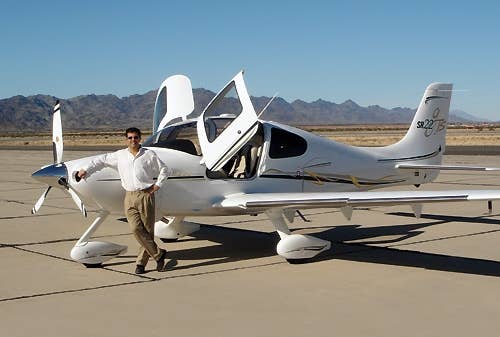
** Rich Karlgaard appreciates the fuel efficiency
of the Cirrus SR22.**
Rich Karlgaard is a late bloomer. At least, in terms of aviation.
"I never had an itch to fly until I read a New York Times Sunday Magazine piece called "Turn Left at Cloud 109" by James Fallows, which appeared on Thanksgiving weekend in 1999," says Karlgaard. "It was about Cirrus. A couple of days later I did two things: (1) scheduled my first lesson at the West Valley Flying Club; (2) bought a newsstand copy of Flying magazine."
In addition to his job as the publisher of Forbes magazine, Karlgaard had co-founded a Silicon Valley startup that, at the end of 1999, looked as if it was going to go public. Anticipating that boost in income, he bought an A36 Bonanza in March 2000 and started taking flying lessons in it. But the dot-com bust forced a restructuring of those plans. "Our IPO collapsed," Karlgaard remembers. "So I sold the Bonanza, and assumed my flying days were over. Except … I was now addicted."
Unwilling to give up the sky, Karlgaard went back to basics. In 2001 he bought a Cessna 172SP and used the plane to complete his private and instrument ratings. He also flew the Cessna around the country to research a book, appropriately titled: Life 2.0, which came out in 2004. In 2003, he upgraded to a new, 2002 Cessna T182T, which he bought in partnership with Reynold Lewke, an executive recruiter with Egon Zehnder International. But two years later, Karlgaard and Lewke switched to a Cirrus -- the plane that had first sparked Karlgaard's imagination and made him want to fly. In January 2006, Karlgaard traveled to Duluth and picked up a brand-new, 2005 Cirrus SR22 GTS.
"The Cessna T182T was a trustworthy steed," Karlgaard says, "but it was underpowered and had poor fuel economy. To keep CHTs under 380, you had to run it at 19 gph. I tried running it lean of peak, but that wouldn't work. Also … I hate turbulence as Indiana Jones hates snakes." And in Karlgaard's opinion, the Cirrus "knifes through" turbulence far better than the Cessna. His wife, Marji, agrees. And while the ballistic parachute on the Cirrus wasn't a main factor in the purchase decision, Karlgaard says it's "a comfort to all of us, especially crossing the mountains."
The Cirrus, which was three years newer than the Cessna, cost about $70,000 more than the 182. But Karlgaard has been very pleased with his investment. "Cirrus is an incredible aircraft," he says. "It's very versatile. It's great for local sight-seeing trips, fast enough for long trips, amazingly fuel efficient when run lean of peak (170 ktas on 13 to 14 gph), and passengers love it."
The Cirrus has also been pretty much trouble-free, in terms of maintenance. "Cirrus quality control was bad in the beginning," Karlgaard says, "but it's steadily improved with each new version." Cirrus owners also benefit from what Karlgaard calls "an extremely opinionated and active users' group -- the Cirrus Owners and Pilots Association (COPA)." Insurance, he says, has been comparable in the Cirrus to what he paid for the Cessna, and fuel costs have been lower.
If there's any downside to the Cirrus, it's the resale value. "There are a lot of planes on the market, suppressing resale value," Karlgaard explains. "There are as many SR22s for sale on Controller.com as there are A36 Bonanzas, but the SR22 has been around only since 2002. Also, a lot of Cirrus buyers were real estate guys and other small business owners, who have been hammered by the downturn."
At the moment, however, Karlgaard has no plans to sell the Cirrus. He uses the plane for both business and pleasure, and says having the Cirrus has enhanced both. "I give a ton of speeches for Forbes and the Washington Speakers Bureau," he explains. "I can fly myself to speeches in the Cirrus, and audiences are impressed. A pilot still has a lot of cachet." The Cirrus also allows the Karlgaards to fly back to the north Midwest, where Karlgaard grew up, more easily.
If he were to wish for another airplane, he says it would only be a turbo version of the Cirrus. "I declared an emergency shortly after takeoff from Santa Fe, because the engine was running rough. Turns out, I forgot to lean it [for the high altitude]. I told my wife God was telling me to buy a turbo." Karlgaard smiles. "My wife had a different opinion."

Sign-up for newsletters & special offers!
Get the latest FLYING stories & special offers delivered directly to your inbox






